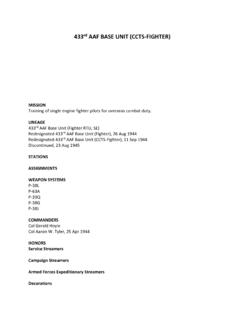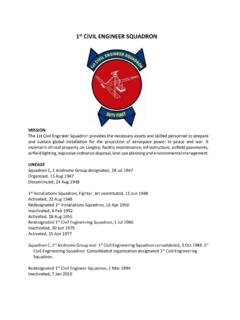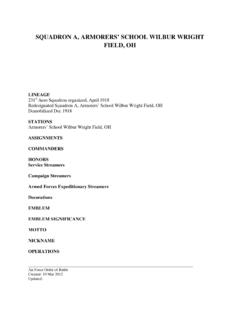Transcription of SAVANNAH COMBAT READINESS TRAINING …
1 SAVANNAH COMBAT READINESS TRAINING center LINEAGE STATIONS SAVANNAH , Garden City, GA ASSIGNMENTS COMMANDERS Col Eugene D. Ashley HONORS Service Streamers Campaign Streamers Armed Forces Expeditionary Streamers Decorations EMBLEM EMBLEM SIGNIFICANCE MOTTO NICKNAME OPERATIONS In September 1952, the Air National Guard Permanent Field TRAINING Site was activated. Where once B-24 engines throbbed and utilizing facilities built by German prisoners of war, generations of Air Guardsmen would gain and fine-tune their COMBAT capability. The Field TRAINING Site concept was the brainchild of Colonel Bill Henry, executive officer to the National Guard Bureau. TRAINING Sites were established to provide a bare base environment for Air Guard units to perform annual TRAINING . The mission was to equip and maintain the installation and provide logistical support to any unit designated by the Chief, National Guard Bureau, to utilize the facilities.
2 In 1952, nine TRAINING Sites were established. Today, only four remain. Lt Col Walter M. Armstead was appointed the first TRAINING Site Commander. The facility he was assigned to command was austere at best, in both facilities and equipment. The first unit to deploy to SAVANNAH was the 149 TFG, Texas ANG in the summer of 1953. It was quickly followed by Guard units from Georgia, Florida, South Carolina, Alabama, Louisiana, and Mississippi. Guardsmen were billeted in 40 squad tents and the aircraft, P-51's and FSO's, operated out of generally inadequate flying facilities. In the beginning, utilization was restricted to the Summer months, June through August. After that first summer, with the success of the TRAINING Site concept, the Site began to expand and provide better facilities for operations and billeting. In December 1953, after that first busy summer, Lt Col Armstead was killed when his T-33 crashed on Wassaw Island, just twenty miles from the TRAINING Site.
3 His replacement was Col Albert S. Ellington, Jr., commander for the next 21 years. During that period the TRAINING Site experienced continuing expansion of its mission and facilities. It became a 365 day a year TRAINING site, supporting not only all aspects for the Air Guard mission, but also all other branches of the service - both active and reserve. Col Ellington was transferred to State Headquarters in Atlanta on 9 July 1974. Col Carl C. Poythress, Jr. then became Commander. The role of the TRAINING Site continued to expand. The Site was now used to support Annual TRAINING , Operation READINESS Evaluations and Inspections and joint force exercises. In January 1981, the TRAINING Site established itself as the premiere Site in the Air National Guard when it became the first to receive an "Excellent" rating on its Management Effectiveness Inspection. Since this date, the SAVANNAH Field TRAINING Site has received six consecutive "Excellent" ratings.
4 This is an unprecedented string of unbroken ratings among TRAINING Sites. SAVANNAH 's continued excellence was also recognized by three Air Force Organizational Excellence Awards. Under Col Poythress the role of the TRAINING Site continued to expand. Facilities continued to improve, services and logistics expanded, administrative and information management support grew. Aerospace Ground Equipment, aircraft maintenance, communication, airfield management, and operations support were established. In 1979, the TRAINING Site began coordination with the Air Force and Marine Corps to reopen the old Navy bombing range in Townsend, Georgia. The Townsend Range, which was operated and maintained by the TRAINING Site, became operational on 1 October 1981, when a flight of four F-105's from the 116 TFW of the Georgia Air National Guard first used it. Townsend soon established itself as one of the finest air-to-ground ranges in the country.
5 In 1985, it received an "Outstanding" rating on its first MEI, the first bombing range ever to receive this rating. By now, the facilities at the TRAINING Site had improved greatly. Gone were the squad tents, replaced by heated and air-conditioned BOQs and airmen's barracks. The operations' building was completely renovated in 1984. The TRAINING Site had evolved into, what was in effect, a miniature Air Force Base lacking only aircraft and personnel. The support required by TRAINING Site personnel to support the expanding mission of the Air Guard as part of the Total Force, continued to increase. In recognition of the importance of TRAINING Sites to the Guard and the key role sites play in maintaining the Guard's COMBAT capability, they were redesigned COMBAT READINESS TRAINING Centers (CRTC) in 1990. The use of the TRAINING center evolved far beyond the original concept of annual TRAINING . Numerous joint force exercises, such as Ninth Air Force's "Quick Thrust" became yearly fixtures at SAVANNAH .
6 In 1989 the Navy A-6 unit VA-125 deployed with Paramount Pictures for filming of "Flight of the Intruder." In the fall of 1994, the Vermont and North Dakota Air National Guard along with Team Canada came to SAVANNAH to train for the WILLIAM TELL competition. These teams made a clean sweep of the top three positions in this worldwide air COMBAT meet. By late 1992 the thrust of TRAINING at the CRTC had changed drastically. The dramatic change in the world order, reorganization within the Air Force and Air Guard, and major budget cuts meant an almost complete elimination of the traditional annual TRAINING . Instead, the CRTC saw a radical increase in ORIs and OREs. This is a challenge the CRTC continues to meet. Since 1984, the CRTC has been working another joint venture to increase TRAINING available to deploying units. Working closely with the National Guard Bureau, the active Air Force, Navy, and Marine Corps, the CRTC procured the Air Guard's second Air COMBAT Maneuvering Instrumentation System (ACMI) which provides computer generated depiction of aircraft engaged in air COMBAT TRAINING .
7 This system was tied into the master range operated by the Beaufort Marine Corps Air Station. This coordination provided cost-effective, state-of-the-art air COMBAT TRAINING in the largest supersonic range available to the Air National Guard. The CRTC's portion of the system became operational on 1 April 1990, adding a new dimension to air-to-air TRAINING at SAVANNAH . Now the SAVANNAH CRTC could truly support all aspects of required Air National Guard TRAINING . In August 1991 all these came together. The CRTC sponsored its first exercise - SENTRY OLYMPIAD, the first exercise planned, executed, and directed entirely by CRTC personnel. The exercise pitted aircraft from six other states as well as Georgia Guard ground control intercept and C-ISO's with active duty Air Force and Army Range support against Marine Corps adversaries. For three days, from 9 to 11 August, Air Guard A-7s, F-16s, F-15s, and RF-4s swirled in mock COMBAT with Marine F-18s, EA-6Bs, and E-2s.
8 The Marines attempted to attack Townsend Range, while the Air Guard struck Beaufort MCAS. The exercise came to its climax when C-130s of the 165 TAG and 8 SOS air assaulted Beaufort MCAS with a company of Rangers. SENTRY OLYMPIAD concluded as an outrageous success that became the precedent for future exercises, such as the Air Guard READY exercise program and the Marine HORNET NEST exercises. In the summer of 1992, Col Poythress retired. The new and present Commander is Col Eugene D. Ashley. By now, the CRTC had taken major roles in its State mission. In 1988, several members of the TRAINING center worked for HAYLIFT that brought aid to drought stricken farmers in the mid-west. During Hurricane Hugo, the CRTC established the Air Guard Command Post in the event the hurricane hit Georgia. In 1993 and 1994, the CRTC personnel aided flood relief in SAVANNAH and Southern Georgia. CRTC personnel also worked with the Chatham County Emergency Management Agency during the Powell-Duffryn chemical fire in 1995.
9 In addition, CRTC guardsmen participated in several contingency operations in support of State Headquarters. During the '96 Centennial Olympic Games, the CRTC hosted the Coast Guard Security Forces for the yachting events. The real purpose of the CRTC was COMBAT READINESS TRAINING . The ability of the CRTC to provide this TRAINING was put to the ultimate test when in 1990 and 1991 America again prepared for I war. When DESERT STORM was unleashed on Iraq, airpower played a pivotal role. The Iraqi army was annihilated by America's overwhelming air might. Every single fighter unit based east of the Mississippi that participated in this air assault had received a significant portion of its TRAINING from SAVANNAH CRTC facilities. The majority of tactical airlift and tanker units also accomplished much of the TRAINING at the CRTC. In February of 1999 and again in Feb 2000, the CRTC had the privilege of hosting the All Service COMBAT Identification Evaluation Team (ASCIET) from Eglin Air Force Base in Florida.
10 More than 5,000 troops from 55 different military units and commercial industry participated in the two-week long join evaluation. ASCIET evaluations are the DoD's primary means to critically analyze how the military identifies enemy targets in a joint COMBAT environment. Additionally, these evaluations provide a unique opportunity for the military to assess emerging COMBAT identification technologies in a joint operational environment. It also provides a forum for communications between industry and military COMBAT identification systems developers and war-fighters. Finally, it provides participants a chance to train in a joint, tactical environment and to receive immediate feedback, thus gaining valuable experience. During their evaluation in SAVANNAH , ASCIET focused on air-to-ground, ground-to-air defense COMBAT identification. Participants included a broad cross section of military forces including Army, Air Force, Marines, Navy and the Royal Air Force from Great Britain.














